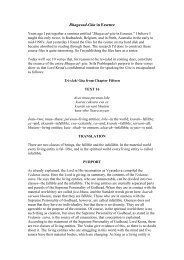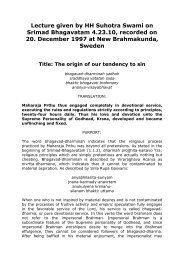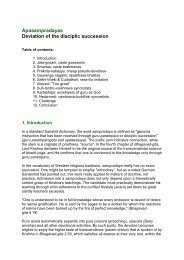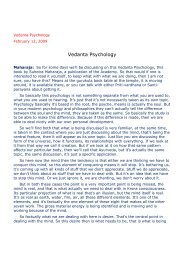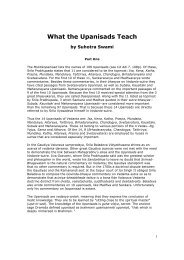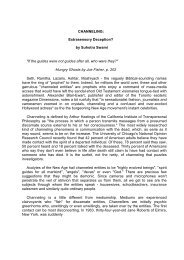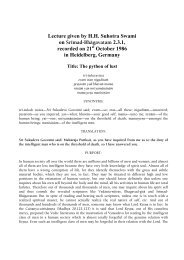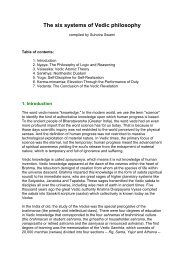Bhakti Sastri intro Suhotra Maharaja the printed version
Bhakti Sastri intro Suhotra Maharaja the printed version
Bhakti Sastri intro Suhotra Maharaja the printed version
You also want an ePaper? Increase the reach of your titles
YUMPU automatically turns print PDFs into web optimized ePapers that Google loves.
Ganges and <strong>the</strong> pure Vaisnava are visnu-padaya, sheltered at <strong>the</strong> lotus feet of LordVisnu. In short, an offense to visnupada is no different from an offense to tadiya andvice-versa. Ei<strong>the</strong>r offense moves <strong>the</strong> Lord to withhold His supreme power that canraise <strong>the</strong> most fallen souls to <strong>the</strong> purified positions of devotional service in practiceand pure love of God,.Now we arrive at something most fundamental to our comprehension of sastricknowledge taught in <strong>the</strong> line of Sri Caitanya Mahaprabhu. Twice Srila Prabhupadadraws our attention to three stages of progress in Vedic education..(A) Wherever <strong>the</strong> word jïäna appears in <strong>the</strong> Vedic literature, it should beunderstood to mean sambandha-jïäna, knowledge of <strong>the</strong> relationship between <strong>the</strong>Lord and His energies. It does not refer to <strong>the</strong> impersonalist concept of <strong>the</strong> Supreme.After a person understands sambandha-jïäna, he comes to <strong>the</strong> stage of abhidheyajïäna,knowledge of how to act in his relationship with <strong>the</strong> Supreme Lord. This isdevotional service, practiced by liberated souls. The mature stage of abhidheya-jïänaleads one to love of Godhead, <strong>the</strong> ultimate goal of all living entities.(B) The last word in knowledge is certainly not self-realization or Brahmanrealization. There is more to realize—namely, that <strong>the</strong> jéva is <strong>the</strong> eternal servant ofLord Kåñëa. This realization is <strong>the</strong> awakening of supramental consciousness, and <strong>the</strong>activities a jéva performs in such consciousness are <strong>the</strong> beginning of his eternal life.When <strong>the</strong> jéva performs all his activities under <strong>the</strong> direction of <strong>the</strong> Lord's internal,spiritual energy, he enjoys eternal transcendental bliss, which is a billion times greaterthan <strong>the</strong> happiness of Brahman realization. The difference in transcendental joybetween <strong>the</strong> two is like <strong>the</strong> difference between <strong>the</strong> vast ocean and <strong>the</strong> water collectedin a calf's hoofprint.The Three Great Riches of LifeIt is clear from <strong>the</strong> above quotations that <strong>the</strong>re are three levels of Vedicknowledge. Repeatedly in Sri Caitanya-caritamrta <strong>the</strong>y are named sambandha,abidheya and prayojana by no less than Mahaprabhu Himself. From what Vedic sourcedoes this three-fold analysis of sastra originate? The answer is Sri Krsna, who isHimself <strong>the</strong> origin of <strong>the</strong> Vedas. This is confirmed by C.c. Madhya 22.103 and <strong>the</strong>purport:martyo yada tyakta-samasta-karmaniveditatma vicikirsito metadamrtatvam pratipadyamanomayatma-bhuyaya ca kalpate vaiThe living entity who is subjected to birth and death attainsimmortality when he gives up all material activities, dedicates hislife to <strong>the</strong> execution of My order, and acts according to My directions.In this way he becomes fit to enjoy <strong>the</strong> spiritual bliss derived fromexchanging loving mellows with Me.PURPORT8



